Related Research Articles
Mesodma is an extinct genus of mammal, a member of the extinct order Multituberculata within the suborder Cimolodonta, family Neoplagiaulacidae. It lived during the upper Cretaceous and Paleocene Periods of what is now North America. The earliest definitive record is from the late Santonian stage strata of the Straight Cliffs Formation. A single premolar tooth from the lower Cenomanian stage strata of the Cedar Mountain Formation has been tentatively assigned to this genus based on its similarity, but its describers noted that it is unlikely that Mesodma lived during that time.
The Coniacian is an age or stage in the geologic timescale. It is a subdivision of the Late Cretaceous Epoch or Upper Cretaceous Series and spans the time between 89.8 ± 1 Ma and 86.3 ± 0.7 Ma. The Coniacian is preceded by the Turonian and followed by the Santonian.
The Santonian is an age in the geologic timescale or a chronostratigraphic stage. It is a subdivision of the Late Cretaceous Epoch or Upper Cretaceous Series. It spans the time between 86.3 ± 0.7 mya and 83.6 ± 0.7 mya. The Santonian is preceded by the Coniacian and is followed by the Campanian.

Achillobator is a genus of large dromaeosaurid theropod dinosaur that lived during the Late Cretaceous period about 96 million to 89 million years ago in what is now the Bayan Shireh Formation of Mongolia. The genus is currently monotypic, only including the type species A. giganticus. The first remains were found in 1989 during a Mongolian-Russian field expedition and later described in 1999. Remains at the type locality of Achillobator may represent additional specimens. It represents the first and largest dromaeosaurid known from the Bayan Shireh Formation.
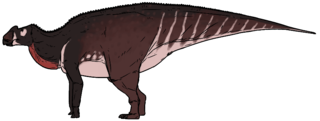
Aralosaurus was a genus of hadrosaurid dinosaur that lived during the Late Cretaceous in what is now Kazakhstan. It is known only by a posterior half of a skull and some post-cranial bones found in the Bostobe Formation in rocks dated from the Upper Santonian-Lower Campanian boundary, at about 83.6 Ma. Only one species is known, Aralosaurus tuberiferus, described by Anatoly Konstantinovich Rozhdestvensky in 1968. The genus name means Aral Sea lizard, because it was found to the northeast of the Aral Sea. The specific epithet tuberiferus means bearing a tuber because the posterior part of the nasal bone rises sharply in front of the orbits like an outgrowth. Aralosaurus was originally reconstituted with a nasal arch similar to that of North American Kritosaurus. For many years, Aralosaurus was thus placed in the clade of the Hadrosaurinae. This classification was invalidated in 2004, following the re-examination of the skull of the animal which allowed to identify in Aralosaurus many typical characters of Lambeosaurinae. In particular, this study revealed that Aralosaurus had a hollow bony structure located far in front of the orbits, which communicated with the respiratory tract. This structure being broken at its base, its shape and size remains undetermined. More recently, Aralosaurus has been identified as the most basal Lambeosaurinae, and placed with its close relative Canardia from the upper Maastrichtian of France in the new clade of Aralosaurini.

Tsagantegia is a genus of medium-sized ankylosaurid thyreophoran dinosaur that lived in Asia during the Late Cretaceous period. The genus is monotypic, including only the type species, T. longicranialis. The specimen consists of a very partial individual, comprising the skull and lacking postcranial remains. Since it only preserves the skull, Tsagantegia is mainly characterized by its elongated snout and the flattened facial osteoderms, greatly differing from other ankylosaurs.

Graciliceratops is a genus of neoceratopsian dinosaurs that lived in Asia during the Late Cretaceous period.
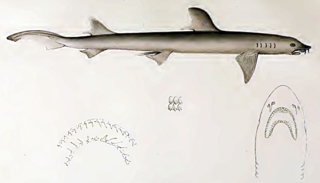
The barbeled houndshark is a species of ground shark and the only member of the family Leptochariidae. This demersal species is found in the coastal waters of the eastern Atlantic Ocean from Mauritania to Angola, at depths of 10–75 m (33–246 ft). It favors muddy habitats, particularly around river mouths. The barbeled houndshark is characterized by a very slender body, nasal barbels, long furrows at the corners of the mouth, and sexually dimorphic teeth. Its maximum known length is 82 cm (32 in).

Inoceramus is an extinct genus of fossil marine pteriomorphian bivalves that superficially resembled the related winged pearly oysters of the extant genus Pteria. They lived from the Early Jurassic to latest Cretaceous.

Anapachydiscus is an extinct cephalopod genus from the Upper Cretaceous, Santonian - Maastrichtian of Europe, Africa, Madagascar, S.India, N Z, Calif. Mexico, Argentina, and the Antarctic belonging to the ammonoid family Pachydiscidae.
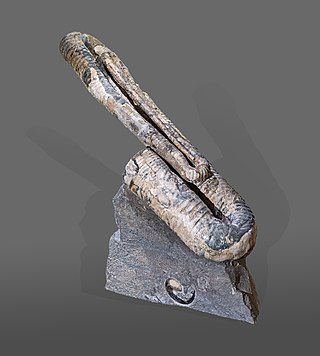
Polyptychoceras is an extinct genus of ammonites from the Late Cretaceous of Asia, Europe, and North and South America. It was first named by Hisakatsu Yabe in 1927.

Peirosauridae is a Gondwanan family of mesoeucrocodylians that lived during the Cretaceous period. It was a clade of terrestrial crocodyliforms that evolved a rather dog-like skull, and were terrestrial carnivores. It was phylogenetically defined in 2004 as the most recent common ancestor of Peirosaurus and Lomasuchinae and all of its descendants. Lomasuchinae is a subfamily of peirosaurids that includes the genus Lomasuchus.

Acynodon is an extinct genus of eusuchian crocodylomorph from the Late Cretaceous, with fossils found throughout Southern Europe.
Compsemys is an extinct genus of prehistoric turtles from the Late Cretaceous and Paleocene of North America and possibly Europe. The type species C. victa, first described by Joseph Leidy from the Hell Creek Formation in Montana in 1856, and another probable species C. russelli, described in 2012, from Paleocene deposits in France. Its affinites have long been uncertain, but it has recently been considered to be the most basal member of Paracryptodira, despite the clade first appearing in the Late Jurassic, and is sometimes included in its own family, Compsemydidae. A revision in 2020 found Compsemydidae to be more expansive, also containing Riodevemys and Selenemys from the Late Jurassic of Europe, and Peltochelys from the Early Cretaceous of Europe.
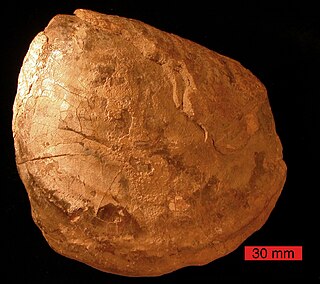
The Inoceramidae are an extinct family of bivalves ("clams") in the Class Mollusca. Fossils of inoceramids are found in marine sediments of Permian to latest Cretaceous in age. Inoceramids tended to live in upper bathyal and neritic environments. Many species of inoceramid are found all over the world, demonstrating the wide distribution of their preferred ecosystems, and possibly long-lived planktotrophic larvae. Despite their wide distribution, the pace of evolution of inoceramids was great, with species ranges commonly averaging 0.2-0.5 Ma.
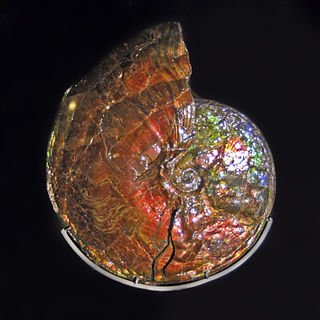
Placenticeratidae is an extinct family of mostly Late Cretaceous ammonites included in the superfamily Hoplitoidea, derived from the Engonoceratidae by an increase in suture complexity.

Foxemys is an extinct genus of bothremydid turtle that was discovered at Fox Amphoux, France and also Hungary and Spain. Its skull and shell structure is similar to Polysternon. Two species are in the genus: F. mechinorum and F. trabanti.

Kallokibotion is an extinct genus of stem-turtle from the Upper Cretaceous, known from fossils found in Romania. One species is known, Kallokibotion bajazidi, which was named by Franz Nopcsa after his lover Bajazid Doda. It literally means 'beautiful box of Bajazid'; Nopcsa chose the name because, in the words of British palaeontologist Gareth Dyke, "the shape of the shell reminded him of Bajazid's arse". A second undescribed species is known from the Santonian of Hungary.

Macrobaenidae is an extinct family of turtles, known from the Early Cretaceous to Paleogene of Laurasia. Their relationships to other turtles and whether or not they form a monophlyletic group are controversial. They are typically interpreted as stem or crown group cryptodires, but some more recent analyses have found them to lie outside crown group Testudines. Macrobaenids can be distinguished from other testudinatans by the presence of a carotid fenestra, cruciform plastron with strap-like epiplastra, and a lack of extragulars.
Binneyitidae is a family of Upper Cretaceous ammonoid cephalopods characterized by rather small, compressed, flat sided shells and sutures that tend to have deep, narrow, simple elements with parallel sides, that range from the upper Cenomanian into the lower Santonian.
References
- Arkell, et al, 1957. Mesozoic Ammonoidea, Treatise on Invertebrate Paleontology, Part L (L370-371). Geological Society of America.
- Desmophyllites in Desmoceratinae